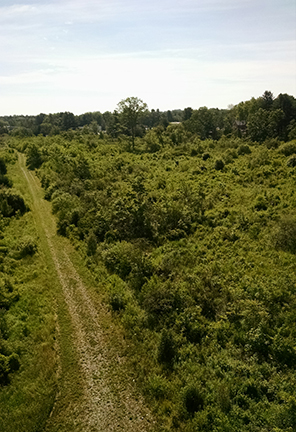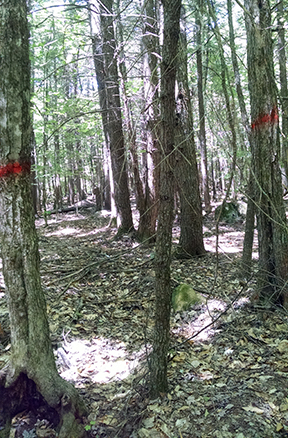August 24, 2016 at 2:48 pm
By Leigh Hoar, Lands Management Biologist
Inland Fisheries and Wildlife’s Wildlife Management Areas are held to provide a statewide, ecologically based system of land holdings for the protection and enhancement of important wildlife habitats that also provide opportunities for public recreation. The focus is on habitat but recreation is a compatible use which serves also to demonstrate the benefits of habitat management for both game and non-game species. IF&W is taking a proactive approach to making the public aware of management activities, where they occur, and the species they are designed to benefit.
Below is an image taken from the observation tower at Scarborough Marsh WMA where recreational users can observe and photograph wading birds in a tidal area immediately to the west. Opposite, and on the walk in to the tower from the east, users can observe and listen to songbirds which require dense shrubland. One might also see grouse, woodcock, turkey, deer, and if they are fortunate, the state endangered New England cottontail. This habitat was created through the removal of white pine, red maple and red oak over topping a thinning shrub component intolerant of shade. The site was formerly a field many years ago. A few hard mast producing species, red oak in this instance, were retained to provide an additional source of food for certain foraging species such as deer and turkey. “Mast” is simply a term for seed.
[caption id="attachment_1878" align="aligncenter" width="296"] A trail at Scarborough[/caption]
Wildlife Management Areas also provide recreational users the opportunity to observe habitat management techniques for species such as deer, which require the dense cover offered by the winter shelter of tree species such as hemlock. Below is an image taken along one of the many walking trails at Jamies Pond WMA in the Manchester area. It shows two red maple trees, marked with orange paint, over topping hemlock. Removal of the red maples serves two purposes. The first purpose is to release the hemlock allowing its crown to expand and further develop, thus enhancing cover for deer. Snow depths are not as great beneath hemlock as they are in hardwood. The second purpose is to provide an additional food source for deer and other browsers such as moose. Red maple, oak and a few other tree species too, sprout from the stump following a harvest, and browsing species eat the buds and smaller stems. You might also note the current absence of existing browse in the picture.
A trail at Scarborough[/caption]
Wildlife Management Areas also provide recreational users the opportunity to observe habitat management techniques for species such as deer, which require the dense cover offered by the winter shelter of tree species such as hemlock. Below is an image taken along one of the many walking trails at Jamies Pond WMA in the Manchester area. It shows two red maple trees, marked with orange paint, over topping hemlock. Removal of the red maples serves two purposes. The first purpose is to release the hemlock allowing its crown to expand and further develop, thus enhancing cover for deer. Snow depths are not as great beneath hemlock as they are in hardwood. The second purpose is to provide an additional food source for deer and other browsers such as moose. Red maple, oak and a few other tree species too, sprout from the stump following a harvest, and browsing species eat the buds and smaller stems. You might also note the current absence of existing browse in the picture.
 Wildlife Management Areas provide the opportunity to bring recreational users, both consumptive and non-consumptive, into the habitat. Grasslands develop into shrublands and young forest, which gradually develop into mature forest. Different wildlife species have different habitat requirements, and IF&W’s management demonstrates a variety of management goals and results for the habitats they either create, maintain or enhance. Approximately 70% of Maine’s Wildlife Management Areas are within 50 miles of the coast. The opportunity to witness the wildlife around us, in its home, is near yours.
Wildlife Management Areas provide the opportunity to bring recreational users, both consumptive and non-consumptive, into the habitat. Grasslands develop into shrublands and young forest, which gradually develop into mature forest. Different wildlife species have different habitat requirements, and IF&W’s management demonstrates a variety of management goals and results for the habitats they either create, maintain or enhance. Approximately 70% of Maine’s Wildlife Management Areas are within 50 miles of the coast. The opportunity to witness the wildlife around us, in its home, is near yours.
 A trail at Scarborough[/caption]
Wildlife Management Areas also provide recreational users the opportunity to observe habitat management techniques for species such as deer, which require the dense cover offered by the winter shelter of tree species such as hemlock. Below is an image taken along one of the many walking trails at Jamies Pond WMA in the Manchester area. It shows two red maple trees, marked with orange paint, over topping hemlock. Removal of the red maples serves two purposes. The first purpose is to release the hemlock allowing its crown to expand and further develop, thus enhancing cover for deer. Snow depths are not as great beneath hemlock as they are in hardwood. The second purpose is to provide an additional food source for deer and other browsers such as moose. Red maple, oak and a few other tree species too, sprout from the stump following a harvest, and browsing species eat the buds and smaller stems. You might also note the current absence of existing browse in the picture.
A trail at Scarborough[/caption]
Wildlife Management Areas also provide recreational users the opportunity to observe habitat management techniques for species such as deer, which require the dense cover offered by the winter shelter of tree species such as hemlock. Below is an image taken along one of the many walking trails at Jamies Pond WMA in the Manchester area. It shows two red maple trees, marked with orange paint, over topping hemlock. Removal of the red maples serves two purposes. The first purpose is to release the hemlock allowing its crown to expand and further develop, thus enhancing cover for deer. Snow depths are not as great beneath hemlock as they are in hardwood. The second purpose is to provide an additional food source for deer and other browsers such as moose. Red maple, oak and a few other tree species too, sprout from the stump following a harvest, and browsing species eat the buds and smaller stems. You might also note the current absence of existing browse in the picture.
 Wildlife Management Areas provide the opportunity to bring recreational users, both consumptive and non-consumptive, into the habitat. Grasslands develop into shrublands and young forest, which gradually develop into mature forest. Different wildlife species have different habitat requirements, and IF&W’s management demonstrates a variety of management goals and results for the habitats they either create, maintain or enhance. Approximately 70% of Maine’s Wildlife Management Areas are within 50 miles of the coast. The opportunity to witness the wildlife around us, in its home, is near yours.
Wildlife Management Areas provide the opportunity to bring recreational users, both consumptive and non-consumptive, into the habitat. Grasslands develop into shrublands and young forest, which gradually develop into mature forest. Different wildlife species have different habitat requirements, and IF&W’s management demonstrates a variety of management goals and results for the habitats they either create, maintain or enhance. Approximately 70% of Maine’s Wildlife Management Areas are within 50 miles of the coast. The opportunity to witness the wildlife around us, in its home, is near yours.Categories